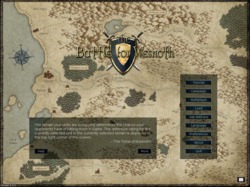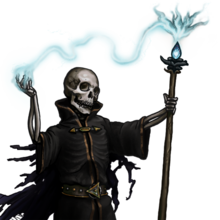The Battle for Wesnoth
| The Battle for Wesnoth | |
|---|---|
 Title screen (1.2.2) | |
| Developer(s) | The Battle for Wesnoth development team |
| Designer(s) | David White and others |
| Engine | custom |
| Platform(s) | Cross-platform |
| Release | October 2 2005 (version 1.0) |
| Genre(s) | Turn-based strategy |
| Mode(s) | Single player, Multiplayer |
The Battle for Wesnoth, or simply Wesnoth, is a free turn-based strategy game designed in June 2003 by David White.
David White based Wesnoth on the Sega Genesis games Master of Monsters and Warsong (also known as Langrisser).[1] He wanted to create a freely-available, open source strategy game that had very simple rules, but had a strong artificial intelligence, and was challenging and fun.[1]
The current stable release of the game is 1.4.4, released on July 23 2008. The Battle for Wesnoth is cross-platform, so it is available for a variety of different operating systems. Released under the GNU General Public License, The Battle for Wesnoth is free software.
Overview

The Battle for Wesnoth is a turn-based strategy game played on a hex map, with single-player campaigns as well as multi-player matches. A central philosophy in the design of the game is the KISS principle; for a new idea to be accepted, it should not complicate gameplay.[2]
Each unit has its own strengths and weaknesses. A unit's defense is based on the type of terrain it stands on, making terrain and placement of units very important. Different types of attacks (melee and ranged), weapon types (pierce, blade, impact, arcane, cold, and fire), and a day-night cycle that alternately favors lawful and chaotic units, add to the strategy. Throughout the campaigns, units can advance to higher level counterparts and become more powerful. Part of the fun is developing a personalized army of advanced units as a campaign progresses.
Game environment
The Battle for Wesnoth is set in a fantasy environment, in which players build armies comprised of different units from races such as humans, elves, dwarves, orcs, trolls, and more. This includes many custom made races, as anyone can customize the game.
The name Wesnoth was originally developed by the game's creator as a combination of syllables that he thought would sound good as a name for a fantasy land. When the project became larger and more elaborate, the developers created a fictional etymology for the name: the inhabitants of the land of Wesnoth came from the West and North, giving Westnorth, which eventually evolved to Wesnoth. This etymology is explained in the campaign The Rise of Wesnoth.
Factions
The Battle for Wesnoth currently has six default factions to choose from:

- Rebels: Consist mostly of elvish units, with ent-like woses, mermen, and mages. Most of their level 1 units are capable of both melee and ranged attacks, making the rebels very versatile. Elves ignore the time of day and have high defense in forests. They are generally faster, but slightly weaker than other units in most other terrain.
- Knalgan Alliance: These consist of slow but sturdy dwarves with strong melee attacks, allied with human outlaws that fight better under the cover of darkness. Generally, dwarves gain a high defense when occupying mountains and hills. Dwarves are also more adept at traversing caves than any other faction and ignore the time of day. They are prone to attack in open terrain, while their human outlaws fight better in this same terrain.
- Loyalists: These are human cavalry, mages and infantry that ordinarily fight better in the daytime, with mermen allies. They are the most diverse faction, with more units than any other faction except the Knalgan Alliance.
- Northerners: A faction of orcs and goblins, along with troll, and naga allies. Their focus is on cheap recruiting, brute force, and close combat, fighting much better at night. Most units require little XP to advance levels. Units often achieve higher mobility when crossing hills.
- Undead: The undead are vulnerable to fire, impact, and arcane attacks, but have high resistance against blade, pierce and especially cold damage. The undead rely on easy access to magic and poison attacks. Some units are able to drain health from enemies in order to replenish their own, and most are immune to poisoning. Unlike other races, most undead units have no traits and no personal names.
- Drakes: A dragon-like race that fights better by day. Most can fly and breathe fire. Their Saurian allies are faster and prefer fighting by night and in swamp areas, though they share the Drakes' vulnerability to cold. Drakes are the most maneuverable faction, though their size makes them prone to attack in most terrain.
The exact units used by the factions, and the faction names, change based on the era or the campaign. The above are the factions of the "Default" era, which is the most played one on the multiplayer servers, and its extension "Age Of Heroes".
There are also a number of user-created factions, several of which are grouped together in downloadable "Eras." For example, the Imperial Era includes the Roman-influenced Lavinians, the Marauders, and the Wild Elves, featuring completely new unit trees and abilities. However, it is quite possible to create factions that can be used in the default eras, though the amount of blessing given by the creators for each may vary.
Campaigns

The stable version of The Battle for Wesnoth currently comes with campaigns each having three levels of difficulty. More campaigns, mostly user-authored ones, can be obtained by clicking on the "Get Add-ons" button which connects the player to the campaign server.
- Heir to the Throne: A young heir, Konrad, allies with rebellious elves and other races to claim the throne from the evil usurper queen Asheviere, her loyalist army, and her orcish mercenaries. This was the original campaign shipped with the game and is still the flagship product, from which most main characters associated with Wesnoth are derived.
- An Orcish Incursion: A beginner's campaign in which you must fight off the first orcs to invade the Great Continent.
- A Tale Of Two Brothers: A Knight's brother is kidnapped by an evil mage after warding off an attack. Now he must rescue him from the mage's clutches.
- Descent into Darkness: Malin Keshar, a young mage from the town of Parthyn, attempts to defend his home from marauding orcs by enlisting the help of a necromancer named Darken Volk. By doing so, he learns the forbidden arts and the true power of the undead.
- Liberty: Several poor villages are betrayed by the Kingdom of Wesnoth, which has recently fallen under the influence of the evil Queen Asheviere. They decide to fight back and become outlaws.
- Northern Rebirth: The people held captive by the orcs in the city of Dwarven Doors rebel against their masters in a struggle that will shape the fate of the Northlands.
- The Eastern Invasion: In this campaign, an officer in the army of Wesnoth known as Gweddry tries to save the kingdom of Wesnoth from an undead invasion.
- Son of the Black Eye: An orc named Kapou'e is the son of the only orc to have unified the orcish tribes, Black-Eye Karun, who was betrayed and murdered by the humans. Kapou'e fights back against the human earldoms and attempts to re-unite the orcish clans under his banner.
- The Hammer of Thursagan: An expedition from Knalga searches for the Hammer of Thursagan. (Written by the well-known hacker and open-source advocate, Eric S. Raymond.)
- The Rise of Wesnoth: This campaign is about the founding of Wesnoth by Prince Haldric, its first king. He must lead his people from the Green Isle, which is being infested by orcs, east towards their future home.
- The Dark Hordes: This Campaign is about a Necromancer named Gwiti Ha'atel who is banished from his homeland and becomes a necromancer in his journey to find Crelanu's book
- The Sceptre of Fire: The story of the creation of the Scepter of Fire, featured in the "Heir to the Throne" campaign, by the Dwarves of Knalga.
- The South Guard: Deoran, a young Knight, is sent to take command of a group known as the South Guard, which is entrenched in many battles with outlaws and undead.
- Under the Burning Suns: This campaign takes place in the distant future of Wesnoth, where the elves live in the desert, under two burning suns. Meteors fell from the sky and destroyed their home, forcing them to embark on a journey following their courageous and visionary leader, Kaleh.
Editor

This section needs expansion. You can help by adding to it. (June 2008) |
Development
The game is programmed in C++. It is cross-platform, and runs on AmigaOS 4, BeOS, FreeBSD, Linux (including OS flavors running on GP2X and Nokia n800 and n810 handheld devices), Mac OS X, Morphos, NetBSD, OpenBSD, RISC OS, Solaris, and Microsoft Windows.
Wesnoth development is decentralized due to its free and open-source nature. The officially-blessed campaigns and units bundled with the game download are often derived from content created by the community, somewhat differently from the user-generated content in proprietary games where such content, while available, is usually not incorporated into official builds of the game. The Wesnoth forums and wiki are used to develop new campaigns, including new unit types and story artwork. The game is able to download new campaigns from a central application server. Content featured on the official campaign server must be licensed under the GNU GPL, like the game itself.
Even when not counting this community content, the list of contributors to the official version of the game as displayed in-game contains almost 400 entries (May 2007). Developers of the game also include well known authors from the free software and open source scene, like the co-founder of the Open Source Initiative Eric S. Raymond [3] or Linux kernel programmer Rusty Russell [4][5].
Releases
In October 2005, the game reached its 1.0 milestone release. On July 23 2008, version 1.4.4 was released. On July 15, 2008, the latest release in the 1.5.x development branch, 1.5.2, was released. Various versions of Wesnoth have been downloaded from the central site over two million times.[6] The game is available in about 42 languages as of June 2008.[7]
Music
Wesnoth's music composers aim at creating a fully orchestrated classical sound track for the game.[8] An example piece:
Template:Multi-listen start Template:Multi-listen item Template:Multi-listen end
See also
References
- ^ a b PCTechTalk :: What's your issue?
- ^ WesnothPhilosophy - Wesnoth
- ^ Developer entry for Eric S. Raymond on gna.org
- ^ Developer entry for Rusty Russell on gna.org
- ^ Video of a talk by Rusty Russell at Australian Linux conference linux.conf.au 2007 about his work on Wesnoth, from here
- ^ Sourceforge stats
- ^ Battle for Wesnoth
- ^ Page for music creators, with further links on the official site
